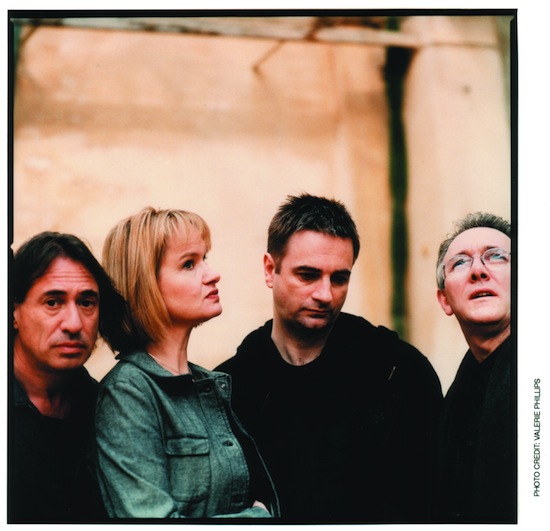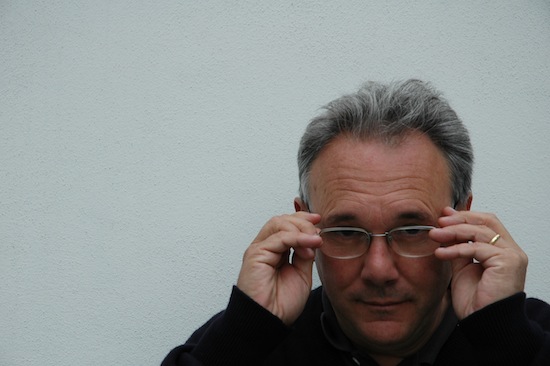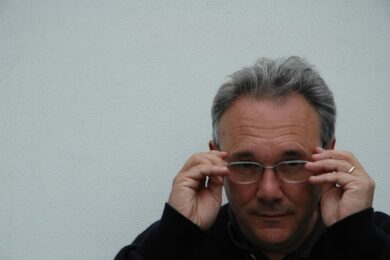Pop music needs institutions, that much is clear. Creative spontaneity and an anarchist ethic will only get you so far – sooner or later, if you want music to have longevity and work as social intervention, you need to create an institutional framework, an organisational structure that will provide a setting for genuine artistic freedom and intellectual development to flourish.
Right now, in our atomised, post-everything pop scene, the lack of a collective countercultural architecture is blindingly apparent. So it is timely that the catalogue of Zang Tuum Tumb Records (ZTT) – a pop institution if ever there was one – is being repackaged and re-released this month in the form of a series of well-designed, copiously sleeve-noted editions to mark the label’s 30th anniversary.
The brainchild of producer/musician Trevor Horn, businesswoman Jill Sinclair, and music-journalist enfant terrible Paul Morley, ZTT was named after a 1914 sound poem by the Italian Futurist F.T. Marinetti, and became the vanguard of the so-called New Pop movement of the early 1980s. With a conceptual grounding in the avant-garde substrata of the twentieth century, ZTT cut against the reactionary mood of the time with a series of brilliant pop Gesamtkunstwerks – Frankie Goes To Hollywood’s ‘Relax’, Propaganda’s A Secret Wish, Art of Noise’s Who’s Afraid Of The Art Of Noise? – all of which juxtaposed future-shock design with playful sloganeering and a production aesthetic that still sounds strange and modernistic over thirty years later.
Remarkably, after having negotiated its way through eighties mega-pop, early hip-hop (ZTT was briefly the UK distributor for Tommy Boy), acid house (see 808 State’s supernal 1989 single ‘Pacific State’), and Seal (of which more momentarily), the label is still run as an independent concern by Horn from his recording base, SARM Studios in Notting Hill.
We caught up with Horn to find him still gabbling with childish excitement in a faded Mackem accent about ZTT, The Art of Noise, ‘Video Killed the Radio Star’, Elizabethan madrigals, and the magic of pop.
There was an incredible sense of idealism at the foundation of ZTT. What ambitions did the project start out with?
Trevor Horn: The way it initially came about was that [Island Records head] Chris Blackwell offered me SARM Studios if I started a record label within Island: ZTT initially started out with Island. Chris Blackwell was a remarkable executive, a really visionary guy. We did a demo for him when we moved into SARM, and the first thing he got from us was Into Battle With The Art Of Noise [the band’s debut EP, released November 1983], which on the surface of it wasn’t very commercial, but he got very excited about it because he could see that it was the first of a new kind of record. It was a very exciting time, and yes, it was very idealistic. One of the first things Jill and I did was bring Paul Morley in to run ZTT and visualise it, and that in itself was an unusual thing to do because Paul was a journalist. But I’d been very, very impressed with Paul’s writing. I always liked to read him because he never quite had the opinion I thought he would about anything, which was always fun. He would like things I thought he’d hate and hate things I thought he’d like.
I was quite interested by the wording of the title of the ZTT anthology: The Organisation Of Pop. Do you think there’s a sense in which pop has to be organised before it means something?
TH: I’ve got to be honest with you, that’s more of a Paul thing than me. That’s the kind of thing Paul would say. I would probably be organising pop music without thinking about the fact that I was organising it.
There is a sense though of your production aesthetic overlapping with that ethos. In comparison with some of the messiness of seventies pop for example, your production was very clean, very pristine, very tightly organised. Did that rhyme with what Paul was saying conceptually?
TH: Yes, there was a definite overlap. Paul was just very inspirational at the start for everybody. The Art of Noise was originally just me, Anne [Dudley], J.J. [Jeczalik], and Gary [Langan] messing about with bits of stuff we’d brought back from South Africa, North America, and various other places. It was Paul who organised us into the Art of Noise. Meanwhile, I cut the first hour of Into Battle out of hours of insanity. So in that sense we did overlap in terms of organisation.
The feeling you get listening to those early ZTT records is of a group of people trying to redefine what a pop song can be. What did that mean for you? Had you had an epiphany moment with pop prior to that?
TH: I had actually, with ‘Walk On By’ by Dionne Warwick. That record really got to me. I thought it was just brilliant. I loved her style of singing because she sounded a bit like an alto sax player, she sounded like Paul Desmond to me. There was no swill. There was no excess anything. It was really simple and clear and beautiful. So I always had that picture in my head. Don’t forget, I come from a musical background, inasmuch as I played in jazz bands as a kid. So harmony always fascinated me because the kind of music I grew up with was far more interesting harmonically than rock & roll was. It took me a while to understand the attitude part of rock & roll, because when I was a kid, I loved The Beatles, but I always found rock & roll a bit bangy and crass and repetitive. I liked it when it started having better tunes. And obviously, like about a gazillion other people, I liked what The Beatles did with it. Everybody does things differently. But this being Great Britain, there are some things that you’re not allowed to do. You’re not allowed to get too musical, otherwise people hate you – like Yes. But I’m a big Yes fan.
So did you feel like you were staking a claim for the pop song as a high art form?
TH: I was just trying to make something that I would enjoy. Something that wasn’t there. And there was so much new stuff around, it was exciting, there were new things that you could do that no-one had ever had the chance to do before, sounds that no-one in history had been able to make before. And the moment you know that’s the case, that’s quite exciting. There was a lot of that at the beginning of the eighties. If you think that when we made ‘Video Killed the Radio Star’ in 1979, there wasn’t a sequencer on it, there were no computers within a mile of it – it’s all played. It sounds like it’s sequenced because we played it to sound like it was sequenced. But by 1983 it had all exploded. What was possible was incredible. Everything was possible suddenly, when it hadn’t been previously.

Some people would say that the pace of technological change has slowed somewhat since then. Do you think that that sense of possibility was confined to the historical moment of the early eighties?
TH: No, but what has happened is that it’s not so visible now. Back at the start of the eighties you were able to sample a sound and make it musical, but now everything’s a sample. Whereas, back then we were sampling things and making a record out of it, now a record’s just a sample. There’s nothing that isn’t a sample, if you get my drift. There was this amazing thing about early sampling, whereby because the technology was primitive, it had a way of romanticising the sound and giving it an otherworldliness that made it seem even more different. Now that all the recording quality is perfect, you have to fake that. But technology’s changed – now all of the gear that we had fits into a computer, and that to me is an even more incredible environment. But you don’t hear that in the records. Back in the early eighties you could hear some shit was going on but you didn’t know what it was. Producers used to come up to me in ’82-’83 and say, ‘How the hell did you do that thing? What was that?’ And of course within a year they all knew. By the time we got to 1986 the little S900 samplers had come out and everyone had access to the same technology.
Listening back to the ZTT catalogue, it seems after the embrace of rave in the late eighties and early nineties, there was a turn back towards towards live musicianship and a warmer sound.
TH: I’d had enough of everybody copying what I did in the early eighties, and I felt that if I made a record like that I’d be copying myself. The records I made with Seal for example were a blend of technology and playing, and when they were good they were a great blend of the two. ‘Crazy’ is still a great sounding track and that’s from 1991 – nearly 25 years ago – a combination of loops, sequenced keyboards, and live guitars. The first Seal album won lots of awards, but by the time we made the second album, the dance thing was really big, and the kind of record we made was very unpopular here. You could tell that things had moved on.
One interesting tune from those years is ‘Kiss From A Rose’, a really weird and wonderful piece of music that seemed to come out of nowhere in the mid-nineties. How did that come about?
TH: I’ll tell you exactly how it came about. When we were making the first album and Seal said to me, "I’ve written this strange song, it’s sort of Elizabethan, almost like a madrigal." I said, "Oh that’s really interesting", and then we forgot about it. But when we were making the second album I said to him: "What about that tune that you said was like a madrigal?" And Seal went in and made a demo himself – one of the few times he’d done that – and he showed up with the demo and that was ‘Kiss From A Rose’. It knocked my socks off when I heard the demo. I’d never heard anything like that, a madrigal with R&B in it. And then figuring out how to do it was really hard. It wasn’t the kind of song you could put drum loops over because it’s in 6/8, and there are hardly any drum loops in 6/8. Also, it’s not in a dance tempo. So I did it in what I thought was a timeless fashion. When it was finished I loved it, but the market research people said it was too old fashioned, which freaked me a bit at the time. Adamski did a great remix for it called ‘Kicks From A Rose’ and I started to think maybe I should have done the record like that. But then Seal got himself a new manager who loved that track and got it onto the end of Batman Forever, and it took off like a rocket. I got the Grammy for it for record of the year. I put it down to the fact that it was a fucking great song, and it had all those wonderful vocal ad libs on it: [sings in falsetto] Bay-baaaay! It reminded me of the kind of songs I used to love but nobody wrote anymore.
The Batman aspect of that narrative is interesting. Tony Wilson once described ZTT as "Raiders Of The Lost Ark box office ethic pop".
TH: Ha!
But you must have had some interesting encounters with that sort of territory over the years. Was that consciously part of a strategy of trying to do something interesting with the mainstream?
TH: You’ve got it in a line. I always feel great if I manage to slip something in that isn’t straightforward. Some of the records I’ve made, if you go away and try to sing them, they’re a bit more complicated than they seem, and it thrills me if I can get a bit of that into the mainstream. And anyway, the pop mainstream always excited me because it seemed like an exciting place to be. I’ve always been obsessed by recording studios and records. I would literally listen to records for seven or eight hours, thinking: how did they do this, how did they do that. Some records I listen to, I can’t tell what the fuck is going on. ‘Like A Rolling Stone’ is a great example. What is going on? How does it get to sound like that, with that piano sound? It really is remarkable. I’ve listened to it ten times in a row and I still can’t work out what’s going on.
What do you think about the format of the mainstream pop song today? Another new release from ZTT is the third volume of a compilation called The Art Of The 12”. The 12” was for a long time the archetypal medium of ZTT, what Paul Morley describes in the sleevenotes for the compilation as a ‘theatre’ for music and ideas. How does the lack of physicality affect the way you produce music now?
TH: Well there’s always a slight lack of quality with music in a computer. Even CDs I miss, because I like having something there – if my computer gets stolen I can just whack it in again. I keep buying the same fucking records over and over again, because they got lost here and there – the Merry Christmas, Mr Lawrence soundtrack by Ryuichi Sakomoto and Hats by the Blue Nile. But that’s the way it goes and everything changes. We’re not going through a great time for the music business. You know when they say, "What do you think about the new business model?" To me it’s a bit like being asked, "What do you think about being raped in every orifice?" I’m still alive, you know. That’s about all you can say.
The Organisation Of Pop, The Art Of The 12" vol. 3 and Frankie Said are all out now on ZTT



